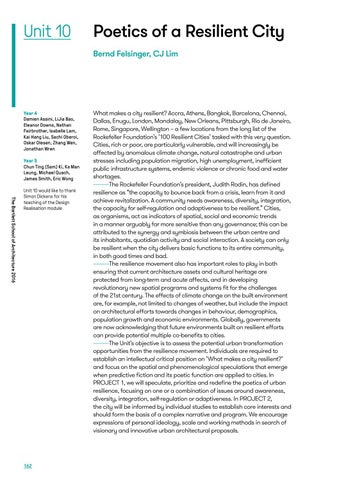Unit 10
Poetics of a Resilient City Bernd Felsinger, CJ Lim
Year 4 Damien Assini, LiJia Bao, Eleanor Downs, Nathan Fairbrother, Isabelle Lam, Kai Hang Liu, Sachi Oberoi, Oskar Olesen, Zhang Wen, Jonathan Wren Year 5 Chun Ting (Sam) Ki, Ka Man Leung, Michael Quach, James Smith, Eric Wong
The Bartlett School of Architecture 2016
Unit 10 would like to thank Simon Dickens for his teaching of the Design Realisation module
162
What makes a city resilient? Accra, Athens, Bangkok, Barcelona, Chennai, Dallas, Enugu, London, Mandalay, New Orleans, Pittsburgh, Rio de Janeiro, Rome, Singapore, Wellington – a few locations from the long list of the Rockefeller Foundation’s ‘100 Resilient Cities’ tasked with this very question. Cities, rich or poor, are particularly vulnerable, and will increasingly be affected by anomalous climate change, natural catastrophe and urban stresses including population migration, high unemployment, inefficient public infrastructure systems, endemic violence or chronic food and water shortages. The Rockefeller Foundation’s president, Judith Rodin, has defined resilience as “the capacity to bounce back from a crisis, learn from it and achieve revitalization. A community needs awareness, diversity, integration, the capacity for self-regulation and adaptiveness to be resilient.” Cities, as organisms, act as indicators of spatial, social and economic trends in a manner arguably far more sensitive than any governance; this can be attributed to the synergy and symbiosis between the urban centre and its inhabitants, quotidian activity and social interaction. A society can only be resilient when the city delivers basic functions to its entire community, in both good times and bad. The resilience movement also has important roles to play in both ensuring that current architecture assets and cultural heritage are protected from long-term and acute affects, and in developing revolutionary new spatial programs and systems fit for the challenges of the 21st century. The effects of climate change on the built environment are, for example, not limited to changes of weather, but include the impact on architectural efforts towards changes in behaviour, demographics, population growth and economic environments. Globally, governments are now acknowledging that future environments built on resilient efforts can provide potential multiple co-benefits to cities. The Unit’s objective is to assess the potential urban transformation opportunities from the resilience movement. Individuals are required to establish an intellectual critical position on ‘What makes a city resilient?’ and focus on the spatial and phenomenological speculations that emerge when predictive fiction and its poetic function are applied to cities. In PROJECT 1, we will speculate, prioritize and redefine the poetics of urban resilience, focusing on one or a combination of issues around awareness, diversity, integration, self-regulation or adaptiveness. In PROJECT 2, the city will be informed by individual studies to establish core interests and should form the basis of a complex narrative and program. We encourage expressions of personal ideology, scale and working methods in search of visionary and innovative urban architectural proposals.
